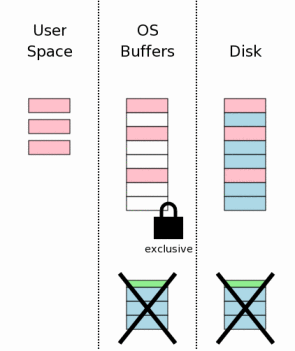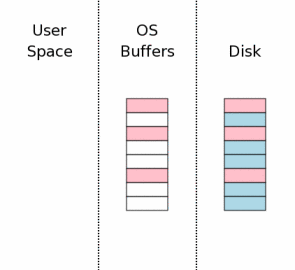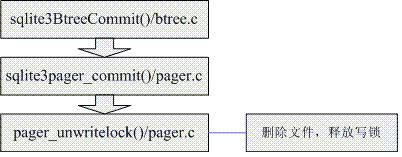- 浏览: 29958 次
- 性别:

- 来自: 广州
-

ÊñáÁ´ÝÂàÜÁ±ª
社区版块
- 我的资讯 ( 0)
- 我的论坛 ( 45)
- 我的问答 ( 1)
存档分类
- 2011-01 ( 1)
- 2010-12 ( 2)
- 2010-11 ( 17)
- 更多存档...
最新评论
(转)SQLite入门与分析(四)---Page Cache之事务处理(3)
- 博客分类:
- 收藏转发
写在前面:由于
内容较多,所以断续没有写完的内容。
11„ÄÅ
ÂàÝÈô§Êó•ÂøóÊñቪ∂(Deleting The Rollback Journal)
ÂàÝÈô§Êñቪ∂Êú¨Ë¥®‰∏ä‰∏çÊò؉∏ĉ∏™ÂéüÂ≠êÊìç‰ΩúÔºå‰ΩÜÊò؉ªéÁî®Êà∑ËøõÁ®ãÁöÑËßíÂ∫¶Êù•ÁúãÊò؉∏ĉ∏™ÂéüÂ≠êÊìç‰ΩúÔºåÊâĉª•‰∏ĉ∏™‰∫ãÂä°Áúã˵∑Êù•Êò؉∏ĉ∏™
ÂéüÂ≠êÊìç‰Ωú„ÄÇ ¬Ý 12„ÄÅ
释放锁(Releasing The Lock)
¬Ý ‰ª•‰∏ä‰∏§Ê≠•ÊòØÂú®
sqlite3BtreeCommit
()---btree.c函数中实现
ÁöÑ„ÄÇ
‰ª£ÁÝŶlj∏ãÔºö
下图可进一步描述该过程:
¬Ý ÊúÄÂêéÊù•ÁúãÁúã
sqlite3BtreeSync()Âíåsqlite3BtreeCommit
()
是如何被调用的。
‰∏ÄËà¨Êù•ËØ¥Ôºå‰∫ãÂä°Êèê‰∫§Êñπºè‰∏∫Ëá™Âä®Êèê‰∫§ÁöÑËØùÔºåÂú®ËôöÊãüÊú∫‰∏≠ÁöÑOP_HaltÊåቪ§ÂÆûÁé∞Êèê‰∫§‰∫ãÂä°ÔºåÁõ∏ÂÖ≥‰ª£ÁÝŶlj∏ãÔºö
![]() Code
Code
‰∏ÄÊó¶Êõ¥ÊîπÂÜôÂÖ•ËÆæ§áÔºåÊó•ÂøóÊñቪ∂Â∞܉ºöË¢´ÂàÝ
Èô§ÔºåËøôÊò؉∫ãÂä°ÁúüÊ≠£Êèê‰∫§ÁöÑÊó∂Â઄ÄǶÇÊûúÂú®Ëøô‰πãÂâçÁ≥ªÁªüÂèëÁîüÂ¥©Ê∫ÉÔºåÂ∞±‰ºöËøõË°åÊާç§ÑÁêÜÔºå‰ΩøÂæóÊï∞ÊçÆÂ∫ìÂíåÊ≤°ÂèëÁîüÊîπÂèò‰∏ÄÊÝ∑Ôºõ¶ÇÊûúÂú®Ëøô‰πãÂêéÁ≥ªÁªüÂèëÁîüÂ¥©Ê∫ÉÔºåË°®ÊòéÊâÄÊúâÁöÑÊõ¥ÊîπÈÉΩÂ∑≤
ÁªèÂÜôÂÖ•Á£ÅÁõò„ÄÇSQLiteÂ∞±ÊòØÊÝπÊçÆÊó•ÂøóÂ≠òÂú®ÊÉÖÂܵÂÜ≥ÂÆöÊòØÂê¶ÂØπÊï∞ÊçÆÂ∫ìËøõË°åÊާç§ÑÁêÜ„ÄÇ
Âú®ËÆ∏§öÁ≥ªÁªü‰∏≠ÔºåÂàÝÈô§Êñቪ∂‰πüÊò؉∏ĉ∏™È´ò‰ª£‰ª∑ÁöÑÊìç‰Ωú„ÄljΩú‰∏∫‰ºòÂåñÔºåSQLiteÂè؉ª•ÈÖçÁΩÆÊàêÊääÊó•ÂøóÊñቪ∂ÁöÑÈïøÂ∫¶Êà™‰∏∫0ÊàñËÄÖÊääÊó•ÂøóÊñቪ∂§¥Ê∏ÖÈõ∂„ÄÇ

作为原子提交的最后一步,释放排斥锁使得其它进程可以开始访问数据
库了。
‰∏ãÂõæ‰∏≠ÔºåÊà뉪¨ÊåáÊòé‰∫ÜÂΩìÈîÅË¢´ÈáäÊîæÁöÑÊó∂ÂÄôÁî®Êà∑Á©∫Èó¥ÊâÄÊã•ÊúâÁöщø°ÊÅØÂ∑≤ÁªèË¢´Ê∏ÖÁ©∫‰∫Ü.ÂØπ‰∫éËÄÅÁâàÊú¨ÁöÑSQLite‰ΩÝÂèØËøô‰πàËƧ‰∏∫„ÄljΩÜÊúÄÊñ∞ÁöÑSQLite‰ºö‰øù
存些用户空间的缓存不会被清空—万一下一个事务开始的时候,这些数据刚好可以用上呢。重新利用这些内存要比再次从操作系统磁盘缓存或者硬盘中读取要来得轻
松与快捷得多,何乐而不为呢?在再次使用这些数据之前,我们必须先取得一个共享锁,同时我们还不得不去检查一下,保证还没有其他进程在我们拥有共享锁之前
对数据库文件进行了修改。数据库文件的第一页中有一个计数器,数据库文件每做一次修改,这个计数器就会增长一下。我们可以通过检查这个计数器就可得知是否
ÊúâÂÖ∂‰ªñËøõÁ®ã‰øÆÊîπËøáÊï∞ÊçÆÂ∫ìÊñቪ∂„ÄǶÇÊûúÊï∞ÊçÆÂ∫ìÊñቪ∂Â∑≤ÁªèË¢´‰øÆÊîπËøá‰∫ÜÔºåÈÇ£‰πàÁî®Êà∑ÂÜÖÂ≠òÁ©∫Èó¥ÁöÑÁºìÂ≠òÂ∞±‰∏çÂæó‰∏çÊ∏ÖÁ©∫ÔºåÂπ∂ÈáçÊñ∞ËتÂÖ•„ÄǧߧöÊï∞ÊÉÖÂܵ‰∏ãÔºåËøôÁßçÊÉÖÂܵ‰∏ç§߉ºöÂèëÁîüÔºåÂõÝÊ≠§
用户空间的内存缓存将是有效的,这对于性能提高来说作用是显著的。

![]()
//提交事务,至此一个事务完成.主要做两件事:
//ÂàÝÈô§Êó•ÂøóÊñቪ∂,ÈáäÊîæÊï∞ÊçÆÂ∫ìÊñቪ∂ÁöÑÂÜôÈîÅ
int sqlite3BtreeCommit(Btree *p){
BtShared *pBt = p->pBt;
btreeIntegrity(p);
/* If the handle has a write-transaction open, commit the shared-btrees
** transaction and set the shared state to TRANS_READ.
*/
if( p->inTrans==TRANS_WRITE ){
int rc;
assert( pBt->inTransaction==TRANS_WRITE );
assert( pBt->nTransaction>0 );
//调用pager,提交事务
rc = sqlite3pager_commit(pBt->pPager);
if( rc!=SQLITE_OK ){
return rc;
}
pBt->inTransaction = TRANS_READ;
pBt->inStmt = 0;
}
unlockAllTables(p);
/* If the handle has any kind of transaction open, decrement the transaction
** count of the shared btree. If the transaction count reaches 0, set
** the shared state to TRANS_NONE. The unlockBtreeIfUnused() call below
** will unlock the pager.
*/
if( p->inTrans!=TRANS_NONE ){
pBt->nTransaction--;
if( 0==pBt->nTransaction ){
pBt->inTransaction = TRANS_NONE;
}
}
}
//提交事务,主要调用pager_unwritelock()函数
int sqlite3pager_commit(Pager *pPager){
int rc;
PgHdr *pPg;
if( pPager->errCode ){
return pPager->errCode;
}
if( pPager->state<PAGER_RESERVED ){
return SQLITE_ERROR;
}
TRACE2("COMMIT %d\n", PAGERID(pPager));
if( MEMDB ){
pPg = pager_get_all_dirty_pages(pPager);
while( pPg ){
clearHistory(PGHDR_TO_HIST(pPg, pPager));
pPg->dirty = 0;
pPg->inJournal = 0;
pPg->inStmt = 0;
pPg->needSync = 0;
pPg->pPrevStmt = pPg->pNextStmt = 0;
pPg = pPg->pDirty;
}
pPager->pDirty = 0;
#ifndef NDEBUG
for(pPg=pPager->pAll; pPg; pPg=pPg->pNextAll){
PgHistory *pHist = PGHDR_TO_HIST(pPg, pPager);
assert( !pPg->alwaysRollback );
assert( !pHist->pOrig );
assert( !pHist->pStmt );
}
#endif
pPager->pStmt = 0;
pPager->state = PAGER_SHARED;
return SQLITE_OK;
}
if( pPager->dirtyCache==0 ){
/* Exit early (without doing the time-consuming sqlite3OsSync() calls)
** if there have been no changes to the database file. */
assert( pPager->needSync==0 );
rc = pager_unwritelock(pPager);
pPager->dbSize = -1;
return rc;
}
assert( pPager->journalOpen );
rc = sqlite3pager_sync(pPager, 0, 0);
//ÂàÝÈô§Êñቪ∂,ÈáäÊîæÂÜôÈîÅ
if( rc==SQLITE_OK ){
rc = pager_unwritelock(pPager);
pPager->dbSize = -1;
}
return rc;
}
//ÂØπÊï∞ÊçÆÂ∫ìÂäÝread lockÔºåÂàÝÈô§Êó•ÂøóÊñቪ∂
static int pager_unwritelock(Pager *pPager){
PgHdr *pPg;
int rc;
assert( !MEMDB );
if( pPager->state<PAGER_RESERVED ){
return SQLITE_OK;
}
sqlite3pager_stmt_commit(pPager);
if( pPager->stmtOpen ){
sqlite3OsClose(&pPager->stfd);
pPager->stmtOpen = 0;
}
if( pPager->journalOpen ){
//关闭日志文件
sqlite3OsClose(&pPager->jfd);
pPager->journalOpen = 0;
//ÂàÝÈô§Êó•ÂøóÊñቪ∂
sqlite3OsDelete(pPager->zJournal);
sqliteFree( pPager->aInJournal );
pPager->aInJournal = 0;
for(pPg=pPager->pAll; pPg; pPg=pPg->pNextAll){
pPg->inJournal = 0;
pPg->dirty = 0;
pPg->needSync = 0;
#ifdef SQLITE_CHECK_PAGES
pPg->pageHash = pager_pagehash(pPg);
#endif
}
pPager->pDirty = 0;
pPager->dirtyCache = 0;
pPager->nRec = 0;
}else{
assert( pPager->aInJournal==0 );
assert( pPager->dirtyCache==0 || pPager->useJournal==0 );
}
//ÈáäÊîæÂÜôÈîÅÔºåÂäÝËتÈîÅ
rc = sqlite3OsUnlock(pPager->fd, SHARED_LOCK);
pPager->state = PAGER_SHARED;
pPager->origDbSize = 0;
pPager->setMaster = 0;
pPager->needSync = 0;
pPager->pFirstSynced = pPager->pFirst;
return rc;
}
¬Ý//ËôöÊãüÊú∫ÂÅúÊú∫Êåቪ§
case OP_Halt: { /* no-push */
p->pTos = pTos;
p->rc = pOp->p1;
p->pc = pc;
p->errorAction = pOp->p2;
if( pOp->p3 ){
sqlite3SetString(&p->zErrMsg, pOp->p3, (char*)0);
}
//设置虚拟机状态 SQLITE_MAGIC_RUN 为 SQLITE_MAGIC_HALT,
//并提交事务
rc = sqlite3VdbeHalt(p);
assert( rc==SQLITE_BUSY || rc==SQLITE_OK );
if( rc==SQLITE_BUSY ){
p->rc = SQLITE_BUSY;
return SQLITE_BUSY;
}
return p->rc ? SQLITE_ERROR : SQLITE_DONE;
}
//当虚拟机要停机时,调用该函数,如果VDBE改变了数据库且为自动
//提交模式,则提交这些改变
int sqlite3VdbeHalt(Vdbe *p){
sqlite3 *db = p->db;
int i;
int (*xFunc)(Btree *pBt) = 0; /* Function to call on each btree backend */
int isSpecialError; /* Set to true if SQLITE_NOMEM or IOERR */
/* This function contains the logic that determines if a statement or
** transaction will be committed or rolled back as a result of the
** execution of this virtual machine.
**
** Special errors:
**
** If an SQLITE_NOMEM error has occured in a statement that writes to
** the database, then either a statement or transaction must be rolled
** back to ensure the tree-structures are in a consistent state. A
** statement transaction is rolled back if one is open, otherwise the
** entire transaction must be rolled back.
**
** If an SQLITE_IOERR error has occured in a statement that writes to
** the database, then the entire transaction must be rolled back. The
** I/O error may have caused garbage to be written to the journal
** file. Were the transaction to continue and eventually be rolled
** back that garbage might end up in the database file.
**
** In both of the above cases, the Vdbe.errorAction variable is
** ignored. If the sqlite3.autoCommit flag is false and a transaction
** is rolled back, it will be set to true.
**
** Other errors:
**
** No error:
**
*/
if( sqlite3MallocFailed() ){
p->rc = SQLITE_NOMEM;
}
if( p->magic!=VDBE_MAGIC_RUN ){
/* Already halted. Nothing to do. */
assert( p->magic==VDBE_MAGIC_HALT );
return SQLITE_OK;
}
//ÈáäÊîæËôöÊãüÊú∫‰∏≠ÊâÄÊúâÁöÑÊ∏∏ÊÝá
closeAllCursors(p);
checkActiveVdbeCnt(db);
/* No commit or rollback needed if the program never started */
if( p->pc>=0 ){
/* Check for one of the special errors - SQLITE_NOMEM or SQLITE_IOERR */
isSpecialError = ((p->rc==SQLITE_NOMEM || p->rc==SQLITE_IOERR)?1:0);
if( isSpecialError ){
/* This loop does static analysis of the query to see which of the
** following three categories it falls into:
**
** Read-only
** Query with statement journal
** Query without statement journal
**
** We could do something more elegant than this static analysis (i.e.
** store the type of query as part of the compliation phase), but
** handling malloc() or IO failure is a fairly obscure edge case so
** this is probably easier. Todo: Might be an opportunity to reduce
** code size a very small amount though
*/
int isReadOnly = 1;
int isStatement = 0;
assert(p->aOp || p->nOp==0);
for(i=0; i<p->nOp; i++){
switch( p->aOp[i].opcode ){
case OP_Transaction:
isReadOnly = 0;
break;
case OP_Statement:
isStatement = 1;
break;
}
}
/* If the query was read-only, we need do no rollback at all. Otherwise,
** proceed with the special handling.
*/
if( !isReadOnly ){
if( p->rc==SQLITE_NOMEM && isStatement ){
xFunc = sqlite3BtreeRollbackStmt;
}else{
/* We are forced to roll back the active transaction. Before doing
** so, abort any other statements this handle currently has active.
*/
sqlite3AbortOtherActiveVdbes(db, p);
sqlite3RollbackAll(db);
db->autoCommit = 1;
}
}
}
/* If the auto-commit flag is set and this is the only active vdbe, then
** we do either a commit or rollback of the current transaction.
**
** Note: This block also runs if one of the special errors handled
** above has occured.
*/
//如果自动提交事务,则提交事务
if( db->autoCommit && db->activeVdbeCnt==1 ){
if( p->rc==SQLITE_OK || (p->errorAction==OE_Fail && !isSpecialError) ){
/* The auto-commit flag is true, and the vdbe program was
** successful or hit an 'OR FAIL' constraint. This means a commit
** is required.
*/
//提交事务
int rc = vdbeCommit(db);
if( rc==SQLITE_BUSY ){
return SQLITE_BUSY;
}else if( rc!=SQLITE_OK ){
p->rc = rc;
sqlite3RollbackAll(db);
}else{
sqlite3CommitInternalChanges(db);
}
}else{
sqlite3RollbackAll(db);
}
}else if( !xFunc ){
if( p->rc==SQLITE_OK || p->errorAction==OE_Fail ){
xFunc = sqlite3BtreeCommitStmt;
}else if( p->errorAction==OE_Abort ){
xFunc = sqlite3BtreeRollbackStmt;
}else{
sqlite3AbortOtherActiveVdbes(db, p);
sqlite3RollbackAll(db);
db->autoCommit = 1;
}
}
/* If xFunc is not NULL, then it is one of sqlite3BtreeRollbackStmt or
** sqlite3BtreeCommitStmt. Call it once on each backend. If an error occurs
** and the return code is still SQLITE_OK, set the return code to the new
** error value.
*/
assert(!xFunc ||
xFunc==sqlite3BtreeCommitStmt ||
xFunc==sqlite3BtreeRollbackStmt
);
for(i=0; xFunc && i<db->nDb; i++){
int rc;
Btree *pBt = db->aDb[i].pBt;
if( pBt ){
rc = xFunc(pBt);
if( rc && (p->rc==SQLITE_OK || p->rc==SQLITE_CONSTRAINT) ){
p->rc = rc;
sqlite3SetString(&p->zErrMsg, 0);
}
}
}
/* If this was an INSERT, UPDATE or DELETE and the statement was committed,
** set the change counter.
*/
if( p->changeCntOn && p->pc>=0 ){
if( !xFunc || xFunc==sqlite3BtreeCommitStmt ){
sqlite3VdbeSetChanges(db, p->nChange);
}else{
sqlite3VdbeSetChanges(db, 0);
}
p->nChange = 0;
}
/* Rollback or commit any schema changes that occurred. */
if( p->rc!=SQLITE_OK && db->flags&SQLITE_InternChanges ){
sqlite3ResetInternalSchema(db, 0);
db->flags = (db->flags | SQLITE_InternChanges);
}
}
/* We have successfully halted and closed the VM. Record this fact. */
if( p->pc>=0 ){
db->activeVdbeCnt--;
}
p->magic = VDBE_MAGIC_HALT;
checkActiveVdbeCnt(db);
return SQLITE_OK;
}
//提交事务,主要调用:
//sqlite3BtreeSync()---同步btree, sqlite3BtreeCommit()---提交事务
static int vdbeCommit(sqlite3 *db){
int i;
int nTrans = 0; /* Number of databases with an active write-transaction */
int rc = SQLITE_OK;
int needXcommit = 0;
for(i=0; i<db->nDb; i++){
Btree *pBt = db->aDb[i].pBt;
if( pBt && sqlite3BtreeIsInTrans(pBt) ){
needXcommit = 1;
if( i!=1 ) nTrans++;
}
}
/* If there are any write-transactions at all, invoke the commit hook */
if( needXcommit && db->xCommitCallback ){
sqlite3SafetyOff(db);
rc = db->xCommitCallback(db->pCommitArg);
sqlite3SafetyOn(db);
if( rc ){
return SQLITE_CONSTRAINT;
}
}
/* The simple case - no more than one database file (not counting the
** TEMP database) has a transaction active. There is no need for the
** master-journal.
**
** If the return value of sqlite3BtreeGetFilename() is a zero length
** string, it means the main database is :memory:. In that case we do
** not support atomic multi-file commits, so use the simple case then
** too.
*/
//简单的情况,只有一个数据库文件,不需要master-journal
if( 0==strlen(sqlite3BtreeGetFilename(db->aDb[0].pBt)) || nTrans<=1 ){
for(i=0; rc==SQLITE_OK && i<db->nDb; i++){
Btree *pBt = db->aDb[i].pBt;
if( pBt ){
//同步btree
rc = sqlite3BtreeSync(pBt, 0);
}
}
/* Do the commit only if all databases successfully synced */
//commite事务
if( rc==SQLITE_OK ){
for(i=0; i<db->nDb; i++){
Btree *pBt = db->aDb[i].pBt;
if( pBt ){
sqlite3BtreeCommit(pBt);
}
}
}
}
/* The complex case - There is a multi-file write-transaction active.
** This requires a master journal file to ensure the transaction is
** committed atomicly.
*/
#ifndef SQLITE_OMIT_DISKIO
else{
int needSync = 0;
char *zMaster = 0; /* File-name for the master journal */
char const *zMainFile = sqlite3BtreeGetFilename(db->aDb[0].pBt);
OsFile *master = 0;
/* Select a master journal file name */
do {
u32 random;
sqliteFree(zMaster);
sqlite3Randomness(sizeof(random), &random);
zMaster = sqlite3MPrintf("%s-mj%08X", zMainFile, random&0x7fffffff);
if( !zMaster ){
return SQLITE_NOMEM;
}
}while( sqlite3OsFileExists(zMaster) );
/* Open the master journal. */
rc = sqlite3OsOpenExclusive(zMaster, &master, 0);
if( rc!=SQLITE_OK ){
sqliteFree(zMaster);
return rc;
}
/* Write the name of each database file in the transaction into the new
** master journal file. If an error occurs at this point close
** and delete the master journal file. All the individual journal files
** still have 'null' as the master journal pointer, so they will roll
** back independently if a failure occurs.
*/
for(i=0; i<db->nDb; i++){
Btree *pBt = db->aDb[i].pBt;
if( i==1 ) continue; /* Ignore the TEMP database */
if( pBt && sqlite3BtreeIsInTrans(pBt) ){
char const *zFile = sqlite3BtreeGetJournalname(pBt);
if( zFile[0]==0 ) continue; /* Ignore :memory: databases */
if( !needSync && !sqlite3BtreeSyncDisabled(pBt) ){
needSync = 1;
}
rc = sqlite3OsWrite(master, zFile, strlen(zFile)+1);
if( rc!=SQLITE_OK ){
sqlite3OsClose(&master);
sqlite3OsDelete(zMaster);
sqliteFree(zMaster);
return rc;
}
}
}
/* Sync the master journal file. Before doing this, open the directory
** the master journal file is store in so that it gets synced too.
*/
zMainFile = sqlite3BtreeGetDirname(db->aDb[0].pBt);
rc = sqlite3OsOpenDirectory(master, zMainFile);
if( rc!=SQLITE_OK ||
(needSync && (rc=sqlite3OsSync(master,0))!=SQLITE_OK) ){
sqlite3OsClose(&master);
sqlite3OsDelete(zMaster);
sqliteFree(zMaster);
return rc;
}
/* Sync all the db files involved in the transaction. The same call
** sets the master journal pointer in each individual journal. If
** an error occurs here, do not delete the master journal file.
**
** If the error occurs during the first call to sqlite3BtreeSync(),
** then there is a chance that the master journal file will be
** orphaned. But we cannot delete it, in case the master journal
** file name was written into the journal file before the failure
** occured.
*/
for(i=0; i<db->nDb; i++){
Btree *pBt = db->aDb[i].pBt;
if( pBt && sqlite3BtreeIsInTrans(pBt) ){
rc = sqlite3BtreeSync(pBt, zMaster);
if( rc!=SQLITE_OK ){
sqlite3OsClose(&master);
sqliteFree(zMaster);
return rc;
}
}
}
sqlite3OsClose(&master);
/* Delete the master journal file. This commits the transaction. After
** doing this the directory is synced again before any individual
** transaction files are deleted.
*/
rc = sqlite3OsDelete(zMaster);
assert( rc==SQLITE_OK );
sqliteFree(zMaster);
zMaster = 0;
rc = sqlite3OsSyncDirectory(zMainFile);
if( rc!=SQLITE_OK ){
/* This is not good. The master journal file has been deleted, but
** the directory sync failed. There is no completely safe course of
** action from here. The individual journals contain the name of the
** master journal file, but there is no way of knowing if that
** master journal exists now or if it will exist after the operating
** system crash that may follow the fsync() failure.
*/
return rc;
}
/* All files and directories have already been synced, so the following
** calls to sqlite3BtreeCommit() are only closing files and deleting
** journals. If something goes wrong while this is happening we don't
** really care. The integrity of the transaction is already guaranteed,
** but some stray 'cold' journals may be lying around. Returning an
** error code won't help matters.
*/
for(i=0; i<db->nDb; i++){
Btree *pBt = db->aDb[i].pBt;
if( pBt ){
sqlite3BtreeCommit(pBt);
}
}
}
#endif
return rc;
}
¬Ý
- 2010-11-19 00:01
- 浏览 974
- 评论(0)
- 分类:数据库
- 查看更多
发表评论
-
(转)Andriod是什么
2010-12-02 11:24 1618导读:Sans Serif是Google的 ... -
(转)SQLite入门与分析(六)---再谈SQLite的锁
2010-11-19 00:09 947写在前 面:SQLite封锁机制的实现需要底层文件系统的 ... -
(转)SQLite入门与分析(五)---Page Cache之并发控制
2010-11-19 00:05 1064ÂÜôÂú®ÂâçÈù¢:Êú¨Ëälj∏ªË¶ÅË∞àË ... -
(转)SQLite入门与分析(四)---Page Cache之事务处理(2)
2010-11-18 23:57 1169ÂÜôÂú®ÂâçÈù¢Ôºö‰∏™‰∫∫ËƧ‰∏∫pager±ÇÊòØSQLiteÂÆûÁé∞Êúĉ∏∫ÊÝ∏ÂøÉÁöÑ ... -
(转)SQLite入门与分析(四)---Page Cache之事务处理(1)
2010-11-18 23:53 956ÂÜôÂú®ÂâçÈù¢Ôºö‰ªéÊú¨Á´ÝºÄÂßãÔºåÂ∞ÜÂØπSQLiteÁöÑÊØè‰∏™Ê®°ÂùóËøõË°åËÆ®ËÆ∫„ÄÇ ... -
ÔºàËΩ¨ÔºâSQLiteÂÖ•Èó®‰∏éÂàÜÊûê(‰∏â)---ÂÜÖÊÝ∏ʶÇËø∞(2)
2010-11-18 23:48 1320ÂÜôÂú®ÂâçÈù¢:Êú¨ËäÇ ÊòØÂâç‰∏ ... -
ÔºàËΩ¨ÔºâSQLiteÂÖ•Èó®‰∏éÂàÜÊûê(‰∏â)---ÂÜÖÊÝ∏ʶÇËø∞(1)
2010-11-18 23:41 805ÂÜôÂú®ÂâçÈù¢:‰ªéÊú¨ Á´ÝºÄÂßã, ... -
(转)SQLite入门与分析(二)---设计与概念(续)
2010-11-18 23:38 1048ÂÜôÂú®ÂâçÈù¢:Êú¨ËäÇ ËÆ®ËÆ∫‰∫ãÂä°,‰∫ãÂä°ÊòØDBMSÊúÄÊÝ∏ÂøÉÁöÑÊäÄÊú؉πã‰∏Ä ... -
(转)SQLite入门与分析(二)---设计与概念
2010-11-18 23:35 806ÂÜôÂú®ÂâçÈù¢:Ë∞¢Ë∞¢ÂêщΩçÁöÑ Â ... -
(转)SQLite入门与分析(一)
2010-11-18 23:31 924ÂÜôÂú®ÂâçÈù¢ÔºöÂá∫‰∫éÈ°πÁõÆÁöÑ ÈúÄ˶Å,ÊúÄËøëÊâìÁÆóÂØπSQLiteÁöÑÂÜÖÊÝ∏ ... -
ÔºàËΩ¨ÔºâÊ∑±ÂÖ•ÁÝîÁ©∂BÊÝëÁ¥¢ÂºïÔºà‰∫îÔºâÁª≠
2010-11-18 15:10 9345.3 Èáçª∫ B ÊÝëÁ¥¢Âºï ... -
ÔºàËΩ¨ÔºâÊ∑±ÂÖ•ÁÝîÁ©∂BÊÝëÁ¥¢ÂºïÔºà‰∫îÔºâ
2010-11-18 15:07 12025.¬Ý¬Ý¬Ý¬Ý Èáçª∫ B ... -
ÔºàËΩ¨ÔºâÊ∑±ÂÖ•ÁÝîÁ©∂BÊÝëÁ¥¢ÂºïÔºàÂõõÔºâÁª≠
2010-11-18 14:58 9284.2¬Ý B ÊÝëÁ¥¢ÂºïÁöÑÂØπ‰∫éÂàÝÈô§Ôºà DEL ... -
ÔºàËΩ¨ÔºâÊ∑±ÂÖ•ÁÝîÁ©∂BÊÝëÁ¥¢ÂºïÔºà‰∏â„ÄÅÂõõÔºâ
2010-11-18 14:44 7323.¬Ý¬Ý¬Ý¬Ý B ÊÝëÁ¥¢ ... -
ÔºàËΩ¨ÔºâÊ∑±ÂÖ•ÁÝîÁ©∂BÊÝëÁ¥¢ÂºïÔºà‰∫åÔºâ
2010-11-18 14:20 7672.¬Ý¬Ý¬Ý¬Ý B ÊÝëÁ¥¢ÂºïÁöÑÂÜÖÈÉ®ÁªìÊûÑ ... -
ÔºàËΩ¨ÔºâÊ∑±ÂÖ•ÁÝîÁ©∂BÊÝëÁ¥¢ÂºïÔºà‰∏ÄÔºâ
2010-11-18 14:12 1015Êëò˶ÅÔºö Êú¨ÊñáÂØπB ÊÝëÁ¥¢ÂºïÁöÑÁªìÊûÑ„ÄÅÂÜÖÈÉ®ÁÆ°ÁêÜÁ≠âÊñπÈù¢ÂÅö‰∫܉∏ĉ∏™ÂÖ®Èù¢ ... -
ÔºàËΩ¨ÔºâBÊÝë„ÄÅB-ÊÝë„ÄÅB+ÊÝë„ÄÅB*ÊÝëÈÉΩÊò؉ªÄ‰πà
2010-11-17 23:46 678B ÊÝë ¬Ý¬Ý¬Ý¬Ý¬Ý¬Ý Âç≥‰∫åÂèâÊêú ... -
ÁîªUMLÂõæÊó∂Ê≥®ÊÑèÁöÑÂá݉∏™ÂéüÂàôÔºàËΩ¨Ôºâ
2010-08-03 12:34 1644软件开发中,分析和设计时,文档的编写和思想的交流,经常要绘制各 ... -
‰ΩÝÊò؉∏™ËΩ؉ª∂Êû∂ÊûÑÂ∏àÂêóÔºüÔºàËΩ¨Ôºâ
2010-07-14 11:11 673ºÄÂèëÂíåÊû∂ÊûÑÁöÑÁïåÈôêÈö扪•Ê ... -
(转)同曲异奏——高效能项目团队的五大特点
2010-03-29 00:24 869ÂêåÊõ≤ºÇ•è‚Äî‚ÄîÈ´òÊïàËÉΩÈ°πÁ ...









相关推荐
"sqlite-tools-win-x64-3440200.zip"这个压缩包包含了三个主要的SQLite实用工具,它们分别是sqlite3_analyzer.exe、sqlite3.exe和sqldiff.exe。 1. **sqlite3.exe**:这是SQLite的命令行接口,也是最基础的工具。...
Âú®SQLiteÂÖ•Èó®‰∏éÂàÜÊûê(‰∏É)---ʵÖË∞àSQLiteÁöÑËôöÊãüÊú∫.doc‰∏≠Ôºå‰∏ªË¶ÅËÆ≤Ëߣ‰∫ÜSQLite¶ljΩïÈÄöËøáËôöÊãüÊú∫ÊâßË°åSQLËØ≠Âè•„ÄÇSQLiteÁöÑËôöÊãüÊú∫Ôºå‰πüÁß∞‰∏∫VDBEÔºàVirtual Database EngineÔºâÔºåÊòØSQLiteÁöÑÊÝ∏ÂøÉÁªÑ‰ª∂„ÄÇÂÆÉË¥üË¥£ËߣÊûêSQLËØ≠Âè•ÔºåÂ∞ÜÂÖ∂ËΩ¨Âåñ‰∏∫‰∏Ä...
˵ÝÈÄÅjarÂåÖÔºösqlite-jdbc-3.15.1.jarÔºõ ˵ÝÈÄÅÂéüAPIÊñáÊ°£Ôºösqlite-jdbc-3.15.1-javadoc.jarÔºõ ˵ÝÈÄÅÊ∫ꉪ£ÁÝÅÔºösqlite-jdbc-3.15.1-sources.jarÔºõ ˵ÝÈÄÅMaven‰æù˵ñ‰ø°ÊÅØÊñቪ∂Ôºösqlite-jdbc-3.15.1.pomÔºõ ÂåÖÂê´ÁøªËØëÂêéÁöÑAPIÊñáÊ°£Ôºö...
在“sqlite-tools-linux-x86-3350400.zip”这个压缩包中,包含了以下关键的SQLite工具: 1. **sqlite3**: 这是SQLite的主要命令行接口。用户可以通过这个工具执行SQL语句,创建和管理数据库,查询数据,甚至进行...
sqlite-devel-3.7.17-8.el7.x86_64.rpm
SQLite3.exe ÊòØ SQLite Êï∞ÊçÆÂ∫ìºïÊìéÁöщ∏ĉ∏™ÂëΩ‰ª§Ë°åÊé•Âè£Â∑•ÂÖ∑ÔºåÂÆÉÂÖÅËÆ∏Áî®Êà∑ÈÄöËøáÊñáÊú¨ÂëΩ‰ª§‰∏é SQLite Êï∞ÊçÆÂ∫ìËøõË°å‰∫§‰∫í„ÄÇSQLite Êò؉∏ĉ∏™ÂºÄÊ∫ê„ÄÅËΩªÈáèÁ∫ß„ÄÅËá™ÂåÖÂê´ÁöÑ SQL Êï∞ÊçÆÂ∫ìºïÊìéÔºåÂπøÊ≥õÂ∫îÁ∫éµåÂ֕ºèÁ≥ªÁªüÂíåÁߪÂä®Â∫îÁ∏≠ÔºåÂõ݉∏∫ÂÆÉÊóÝÈúÄ...
对于那些不需要复杂事务处理和并发控制的场景,SQLite 提供了一个简单、高效的解决方案。然而,对于需要高度并发和复杂事务处理的应用,可能需要考虑使用更为强大的数据库系统,如 MySQL 或 PostgreSQL。
SQLite-1.0.66.0-setup安装包
‚Äúsqlite-autoconf‚ÄùÂíå‚Äúsqlite‚ÄùÊÝáÁ≠æÂàôË°®Êòé‰∫ÜÂÆÉÊòØËá™Âä®ÈÖçÁΩÆÁöÑSQLiteÁâàÊú¨Ôºå‰∏éÊÝáÂáÜÁöÑSQLiteÂ∫ìÊúâÂÖ≥„ÄÇËøô‰∫õÊÝáÁ≠æÊúâÂ䩉∫éÁî®Êà∑Âú®ÊêúÁ¥¢ÂíåÁÆ°ÁêÜ˵ÑÊ∫êÊó∂ËøõË°åÂàÜÁ±ªÂíåËØÜÂà´„ÄÇ ÊĪ‰πãÔºå`sqlite-autoconf-3070800-arm.tar.gz` ÂåÖÂê´‰∫܉∏ĉ∏™È¢Ñ...
1. ‰∏ãËΩΩÂπ∂ËߣÂéã"sqlite-dll-win64-x64-3350100.zip"ÔºåËé∑Âèñsqlite3.dll„ÄÇ 2. Â∞Üsqlite3.dllÊîæÂà∞JavaÂ∫îÁî®Á®ãÂ∫èÁöÑÁ±ªË∑ØÂæÑÔºàclasspathÔºâÊàñÁ≥ªÁªüË∑ØÂæщ∏ã„ÄÇ 3. Âú®Java‰ª£ÁÝʼn∏≠ÔºåºïÂÖ•JDBCÈ©±Âä®Ôºà¶Ç"org.sqlite.JDBC"ÔºâÂπ∂ª∫Á´ãÊï∞ÊçÆÂ∫ì...
SQLite入门与分析(四)---Page Cache之事务处理.doc SQLite入门与分析(五)---Page Cache之并发控制.doc SQLite入门与分析(六)---再谈SQLite的锁.doc
SQLiteStudio是一款功能强大的SQLite数据库管理工具,专为Windows操作系统设计。SQLite本身是一个开源、轻量级的嵌入式SQL数据库引擎,广泛应用于各种桌面应用程序、移动设备和服务器环境,尤其适合那些对数据库性能...
--sqllite3 sqlite-shell-win32-x86: sqlite3.exe --svn执行clean up命令时报错“Previous operation has not finished; run 'cleanup' if it was interrupted”。 解决此问题所需文件 2. 为了方便命令行执行,将...
ÊĪÁöÑÊù•ËØ¥Ôºå"sqlite-shell-linux-x86-3080900.zip" ÊòØÂú®LinuxÁéØ¢ɉ∏≠ÁÆ°ÁêÜÂíåÊìç‰ΩúSQLiteÊï∞ÊçÆÂ∫ìÁöÑÈáç˶ÅÂ∑•ÂÖ∑ÔºåÂÆÉÊèê‰æõ‰∫܉∏ĉ∏™Áõ¥Ê镉∏éÊï∞ÊçÆÂ∫ì‰∫§‰∫íÁöÑÁïåÈù¢Ôºå‰ΩøÂæóÊï∞ÊçÆÁÆ°ÁêÜÂèòÂæóÁÆÄÂçïÊòìË°å„ÄÇÊóÝËÆ∫‰ΩÝÊòØÂàùÂ≠¶ËÄÖËøòÊòØÁªèÈ™å‰∏∞ÂØåÁöѺÄÂèëËÄÖÔºåÁÜüÊÇâÂπ∂...
ÈÄöËøáÂàÜÊûêËøô‰∏™Ê∫êÁÝÅÂåÖÔºåºÄÂèëËÄÖÂè؉ª•‰∫ÜËߣÂà∞¶ljΩïÂú®.NETÈ°πÁõƉ∏≠ÈõÜÊàêSQLiteÊï∞ÊçÆÂ∫ìÔºåÂåÖÊã¨Êï∞ÊçÆËÆøÈóƱÇÁöÑËÆæËÆ°„Äʼn∫ãÂä°Â§ÑÁêÜ„ÄÅÈîôËØاÑÁêÜ„ÄÅÊü•ËØ¢ÊûѪ∫Á≠â„ÄÇÂêåÊó∂ÔºåÊ∫êÁÝÅÂåÖËøòÊîØÊåŧöÁßç.NETÁâàÊú¨ÂíåÂπ≥Âè∞Ôºå‰ΩøÂæóºÄÂèëËÄÖÂè؉ª•ÊÝπÊçÆÈ°πÁõÆÈúÄʱÇÈÄâÊã©ÂêàÈÄÇÁöÑ...
sqlite-tools-win32-x86-3290000 是一个SQLite数据库工具在Windows 32位系统上的安装包或目录名称。SQLite是一个C库,提供了一个轻量级的磁盘文件数据库,不需要一个单独的服务器进程或操作系统(不需要配置、安装或...
"SQLite-1.0.66.0-setup" ÊÝáÈ¢òË°®ÊòéËøôÊò؉∏ĉ∏™ÂÖ≥‰∫éSQLiteÊï∞ÊçÆÂ∫ìÁöÑÂÆâË£ÖÁ®ãÂ∫èÔºåÁâàÊú¨Âè∑‰∏∫1.0.66.0„ÄÇËøô‰∏™ÂéãÁº©ÂåÖÂèØËÉΩÂåÖÂê´‰∫ÜÁ∫éÂú®Áî®Êà∑ËÆ°ÁÆóÊú∫‰∏äÂÆâË£ÖSQLiteÁöÑÂøÖ˶ÅÊñቪ∂„ÄÇ ÊèèËø∞‰∏≠ÁöÑÈáç§ç‰ø°ÊÅØ‚ÄúSQLite-1.0.66.0-setup‚ÄùÂèØËÉΩÊò؉∏ĉ∏™...
ÊÝáÈ¢ò "sqlite-netFx40-binary-x64-2010-1.0.106.0" ÊåáÁöÑÊò؉∏ĉ∏™ÈíàÂØπ .NET Framework 4.0 Âπ≥Âè∞ÁöÑ SQLite È©±Âä®Á®ãÂ∫èÁöÑÁâπÂÆöÁâàÊú¨ÔºåÈÄÇÁ∫é64‰ΩçÔºàx64ÔºâÁ≥ªÁªü„ÄÇËøô‰∏™ÁâàÊú¨Âè∑1.0.106.0Ë°®ÊòéËøôÊò؉∏ĉ∏™Êõ¥Êñ∞Á®≥ÂÆöÁâà„ÄÇSQLite Êò؉∏ĉ∏™ËΩªÈáè...